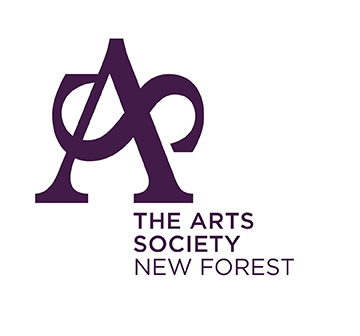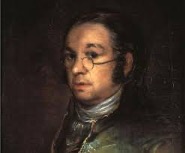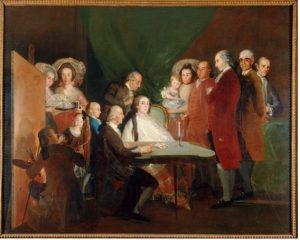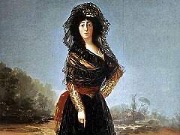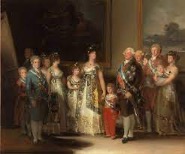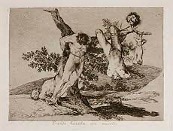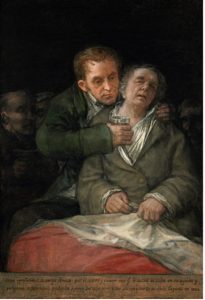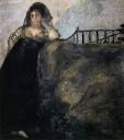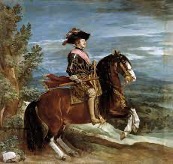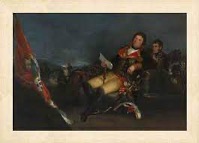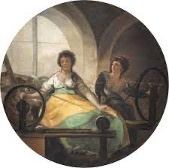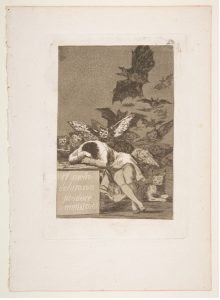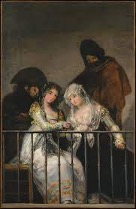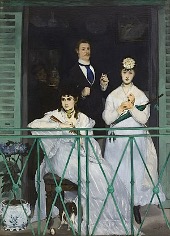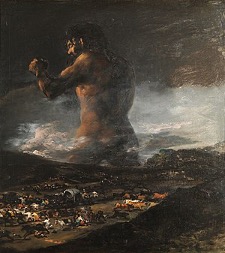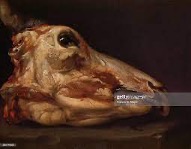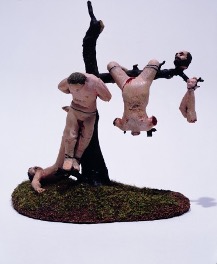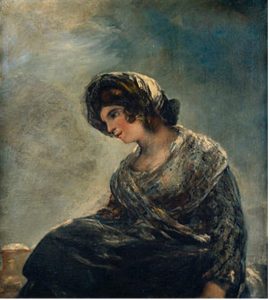Goya -A special Interest day led by Jacqueline Cockburn. November 1st 2021
The first lecture gave us an insight into Goya the person and his historical context including his self-portraiture, rise to court painter, his response to historical events his ongoing health problems and decision to leave Spain.
Francisco José de Goya y Lucientes was born in Fuendetodos, north of Spain. He received schooling and became an artist’s apprentice in Saragossa. He moved to Madrid to study with Anton Raphael Mengs.
Jacqueline asked us to consider the nature of portraiture, compared to a selfie! In those days an artist would gaze into a mirror. The options open to Goya were a ‘direct’ portrait, staring at you, or the head turned to the side (coy) or looking into the distance (thoughtful) or a silhouette.
He fell out with Menga failing to get into the Academy. Instead, he studied with Francisco Bayeu and married his sister Josefa 1773. She bore him seven children but only one son survived.
‘Self portrait with Spectacles’ 1801
Goya was ambitious and his first commission was an altarpiece for San Francisco el Grande (1784). His portrait was included, a practice commonly used by great artists such as Velazquez. His next commission was for the Count of Floridablanca, an influential man including prime minister to Charles III.
Goya’s delight in infiltrating the higher echelons of society is recorded in his correspondence with Zapater (1786). Jacqueline spoke of evidence of his own cultural awareness through inclusions of intellectual references, in the portraits. Goya used such devices as making his subject seem taller by employing the diagonal. The King sent Goya to his brother Don Luis de Borbon to paint the family,
‘The Family of Don Luis de Borbon’ 1783.
Jacqueline spoke about how the study of physiognomy was popular at the time, Goya would have studied ‘Physiognomy’ by Lavatore (1781-6) , she also referenced Thomas Holloway’s book on Silhouettes. Goya’s silhouette could be interpreted as that of a cautious man.
Goya develops tinnitus and becomes deaf. He moves into his own studio. He is commissioned to paint the Duchess of Alba, who is in a relationship with the finance minister. Her lineage is the longest of any other than the royal Family. Her husband dies and Goya moves in with her. He will paint some daring portraits of her.
‘Duchess of Alba’ 1797
The end of the century approaches leading to a Spain on war. The Queen of Spain invites him to paint the Royal Family on the condition he leaves the Duchess of Alba. He complies and is taken on as lead Court painter.
‘The Family of Carlos IV ‘1800.
Napoleon invades Spain, the start of the ‘Peninsular War’. Everything changes, the Spaniards fight back valiantly.
‘Third of May 1808’
The Spanish king is deposed, and the new king Ferdinand is appointed, only to be usurped by Joseph Bonaparte. Goya remains as court painter in Madrid. During this challenging time, he produces ‘The Disasters of War’ prints.
Plate 39: Grande hazaña! Con muertos!
His wife dies in 1812.
In ‘Self portrait ‘1815 (Museo del Prado), Goya portrays his advancing age. In 1819, he had a serious illness and was saved from death by Doctor Arrieta.
In ‘Self Portrait with Doctor Arrieta’ (1820) the doctor supports Goya emulating the Pieta – Mary holding Jesus. (Goya’s green jacket is faded).
Goya retires to Quinta del Sordo, (Villa of the Deaf), where his Black Paintings were painted in oil onto the plaster walls of the house. Analysis has shown that someone else was involved in their construction, it may have been Goya’s son, Javier.
‘La Leocadia’ Mural by Francisco Goya
In 1824, he moves to Bordeaux, where he continues to paint for another eight years, his paintings become brighter once more. He takes with him. Leocadia Weiss, who was his maid companion and possibly his mistress.
He died in 1828 after a stroke. In his will, he left just one portrait to Leocadia.
END OF FIRST LECTURE
SECOND LECTURE
This lecture is about Goya’s modernity and Impact. Modernité relates to the C19th looking back over before and the time, in this instance Modernity is perceived as ‘avant garde’ or even contemporary. Painting is subject to matters of the time, while keeping to the themes of the past. His reassessment of the past is precisely what makes him so modern.
Goya trained in Spain and therefore used the Prado as his source. Jacqueline put up an etching by Goya on the screen and did a comparison between his copy and that of Velazquez. Goya’s portrayal had a more contemporary feel. Velazquez influenced Goya in a major way. Goya managed to convey more about physiognomy, about imperfections. Need to consider the psychology involved. In Velazquez’s equestrian portrait of Phillip IV, was the King controlling his horse or his finance minister?
Goya was adept at Frescoes and was employed by Manuel de Godoy. He painted his portrait with a particularly placed baton (1801) reflecting Godoy’s enjoyment of women.
Goya provides a contemporary feel to paintings emulating Velazquez such as ‘The Weavers’, He paints four tondos for Godoy, a series of allegories about scientific and economic progress for Godoy, Prime Minister for Charles IV. Spain did not undergo an Industrial Revolution.
‘Allegory of Industry’ 1805
Jacqueline spoke in depth about the portrait of the Spanish Royal Family, how Goya incorporates imperfections; the Queen was ‘not famed for her beauty but was proud of her arms’.
These were troubled times – the French Royal Family had been executed in France.
He is invited by Godoy to paint two portraits of the Duchess of Alba for Godoy, one clothed, which was hung above the one with her naked. The latter included pubic hair, considered daring at the time. The Duchess gazes straight out of the painting, intimately.
As the French poet Charles Baudelaire wrote in 1857, “Goya is always a great artist, frequently he is a terrifying one. To the gaiety and joviality of Spanish satire… he adds a more modern attitude, one that has been much sought after in the modern world; a love of the intangible, a feeling for violent contrasts and the terrifying phenomena of nature and strange human physiognomies which in certain circumstances become animalistic.”
Plate number 43: ‘The Sleep of Reason Produces Monsters’ 1799
Los Caprichos is a series of 80 etchings published in 1799 wherein Goya criticized the rampant political, social, and religious abuses of the time period. Of the 80 aquatints, number 43, can be viewed as Goya’s personal manifesto: ‘imagination is what produces works of artistic innovation’.
His take on dreams was likened to the ‘The Nightmare by Fuseli’ 1791. Freud mythologised the notion of the dream.
What happens when Manet emulates Goya? His courtesan adopts the arrangement of Goya’s nude, she places her hand over her pubic hair, implying“You need to pay if you want to see more.” The rise in Prostitution in the nineteenth century was great. Napoleon’s laws safeguarded prostitutes; they each had a medical card.
‘Majas on a Balcony’ 1800-1810
‘The Balcony’ by Edouard Manet 1868
Jacqueline compared Goya’s ‘Shooting 3rd May’: victim about to die with arms akimbo, (like Christ o the Cross), stigmata in his hands, in his yellow trousers, to Picasso’s ‘Massacre in Korea’ 1950
Goya moves to Bordeaux away from his Black Paintings but is still haunted by Death. He paints “Still Life with Golden Bream (1808-1812). Jacqueline spoke of the DEAD fish, the use of colour, the unusual visibility (for this time) of brush strokes. Again in ‘3 Salmon Steaks’ 1812, this is not about eating but about the lumps of dead fish there.
‘Still Life – A Butchers Counter’ 1810-1812
This is around the end of the Peninsular War and Goya denies any religious connotations. Picasso will pick up on this theme with his ‘Still Life with Sheep’s Skulls’ sickened by the horrors of war. Andre Malraux ‘Picasso spoke to me of Goya’.
Dali also pays homage to Goya’s ‘Caprichios’: he buys some and reworks the print by painting over it.
‘The Colossus’ 1808
Dali uses this image for his ‘Premonition of War ‘1936.
Francis Bacon uses Goya for his face painting in ‘Man Eating Soup’
Calf’s Head by Goya
Damien Hurst drew upon this idea for his ‘Mother and Child’ exhibits. He sourced Goya to produce the diamond skull ‘for the love of God’.
Jake and Dinos Chapman worked on Goya’s ideas with their little figures, using them to depict hell.
Questions: Mental health problems? Being deaf must have been disturbing plus the times he lived in. He died happy there is a beautiful painting of Leocadia in ‘Milkmaid of Bordeaux’.
Goya is buried with his son’s wife.
‘Milkmaid of Bordeaux’ 1825-1827
